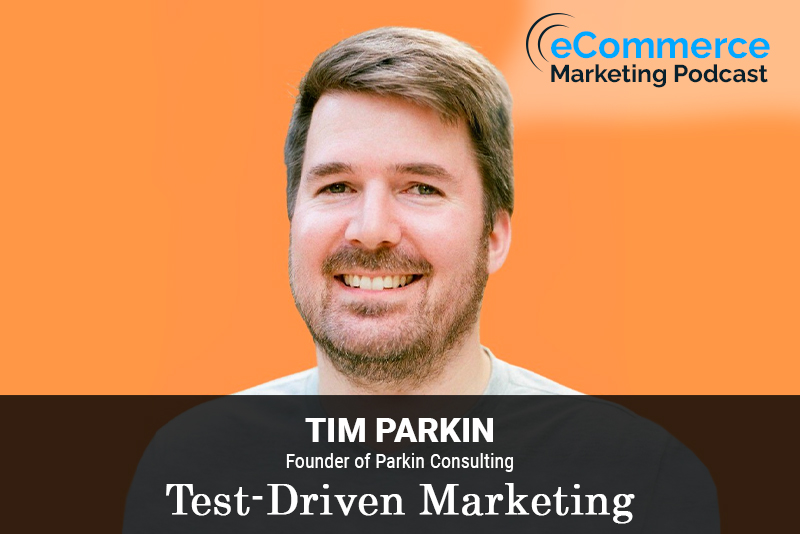
The eCommerce Marketing Podcast walks you through everything that goes into ecommerce marketing — from inbound marketing to paid advertising to conversions. Learn the strategies top marketing experts use to grow their businesses.
Head over to Leadfeeder.com and sign up for a 14-day (no strings attached) free trial!
Tim Parkin is a coach to marketing executives globally. He specializes in helping marketing teams optimize performance, accelerate growth, and maximize their results. By applying more than 20 years of experience merging behavioral psychology and technology, Tim has generated over $100 million for global brands.
In this episode, you will learn
- What is Test-Driven Marketing and how it differs from traditional marketing approaches
- For businesses looking to implement a test-driven approach to their marketing strategies, where should they start
- What key performance indicators (KPIs) should businesses focus on when evaluating the success of their marketing experiments
- What are some of the most common challenges or obstacles companies face when adopting a test-driven marketing approach
- Insights into the tools and technologies that are essential for conducting effective marketing experiments
- How will test-driven marketing evolve and what are some emerging trends or technologies that you believe will significantly impact how businesses experiment with and optimize their marketing strategies
For show transcript and past guests, please visit https://www.ecommercemarketingpodcast.com
Or on YouTube at:
https://www.youtube.com/channel/UC3PgT0NOGzpdPGQtBK0XLIQ
Follow Arlen:
Twitter: https://twitter.com/askarlen
Facebook: https://www.facebook.com/arlen.robinson.7
Instagram: https://www.instagram.com/arlenyohance/
LinkedIn: https://www.linkedin.com/in/arlenrobinson/
Past guests on the ecommerce marketing podcast include Neil Patel, Nemo Chu, Luke Lintz, Luke Carthy, Amber Armstrong, Kris Ruby and many more.
Thanks for listening. Be sure to subscribe and leave a review.

In this episode of the E-Commerce Marketing Podcast, host Arlen Robinson interviews Tim Parkin, a coach to marketing executives globally. Tim specializes in helping marketing teams optimize performance, accelerate growth, and maximize their results. With over 20 years of experience merging behavioral psychology and technology, Tim has generated over $100 million for global brands. The discussion dives into test-driven marketing, highlighting how experimentation can skyrocket conversion rates and maximize revenue for e-commerce businesses.
Key Takeaways
- Introduction and Tim’s Background ([00:02] – [03:35])
- Tim Parkin shares his unique journey from aspiring magician to marketing expert.
- The correlation between magic and marketing, focusing on storytelling, capturing attention, and behavioral psychology.
- What is Test-Driven Marketing? ([04:03] – [06:36])
- Explanation of test-driven marketing and its importance in a constantly changing market.
- The necessity of testing in understanding what works for your specific audience and industry.
- Implementing a Test-Driven Approach ([08:06] – [09:45])
- Starting with identifying what to test by focusing on high-traffic areas and impactful opportunities.
- Importance of analyzing customer feedback and competitor inspiration.
- Importance of Platform Optimization ([10:23] – [12:18])
- How different e-commerce platforms (Shopify, Wix, Squarespace) impact testing and optimization.
- Focusing on the end of the customer journey (cart and checkout) for significant improvements.
- Key Performance Indicators for Testing ([12:54] – [15:14])
- Metrics to focus on, such as revenue per visitor (RPV), add-to-cart rates, and checkout rates.
- The importance of measuring the right metrics to validate the effectiveness of tests.
- Common Challenges in Test-Driven Marketing ([15:39] – [17:44])
- Overcoming internal resistance and fear of negative results from testing.
- Encouraging small, low-risk tests to build confidence and gain buy-in from the team.
- Validating Customer Personas Through Testing ([17:44] – [19:59])
- Using test results to validate or adjust ideal customer personas.
- The importance of leveraging insights from tests to enhance overall marketing strategies.
- Tools and Technologies for Testing ([20:28] – [22:29])
- Recommended tools: Shogun for Shopify, convert.com for A/B testing, Hotjar for heatmaps and session recordings, and Lysna for surveys.
- Benefits of using these tools to gain insights and improve marketing efforts.
- Future of Test-Driven Marketing ([22:51] – [23:54])
- The increasing pace of change in marketing and the necessity of continuous testing.
- Encouragement to start small with testing and gradually build a culture of experimentation.
- Closing Fun Fact and Final Thoughts ([24:31] – [26:37])
- Tim shares his experience as a colorblind individual and its impact on his perspective in marketing.
- The importance of seeing things from the customer’s viewpoint.
Guest Info
Tim Parkin
Founder of Parkin Consulting
Website: Parkin Consulting
LinkedIn: Tim Parkin











